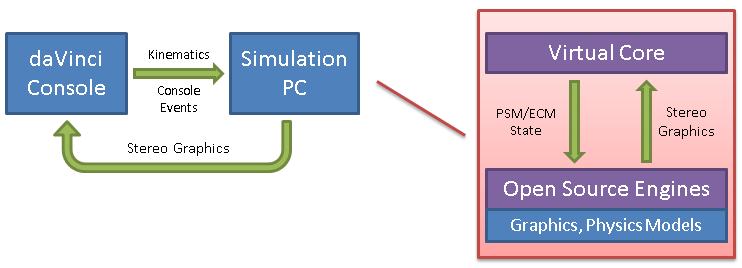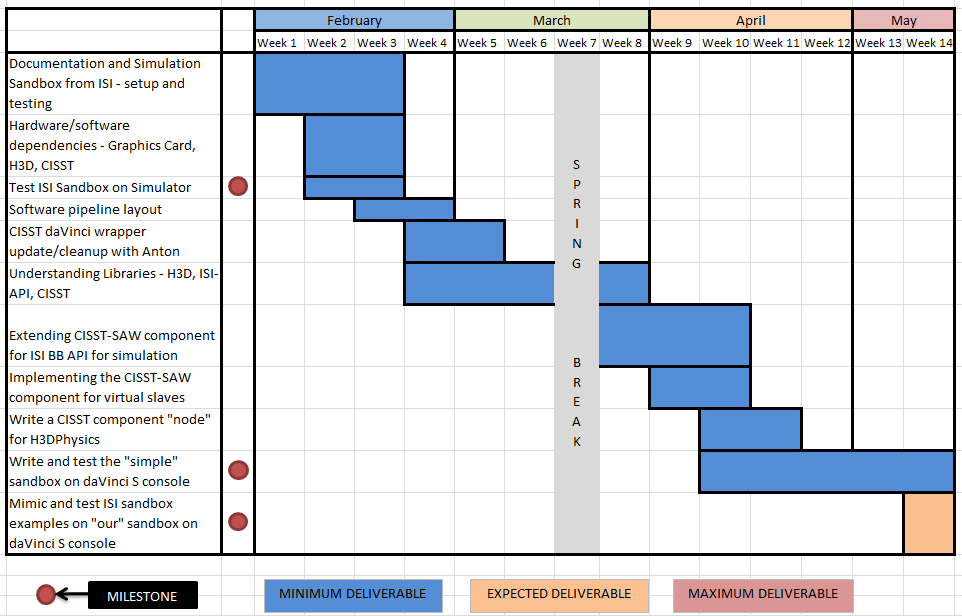Enhanced Surgical Simulation Sandbox for the daVinci System
(CONFIDENTIAL and bounded by NDA with Intuitive Sutrgical Inc.)
Last updated: 5th February 2011 2:38pm
Summary
This project involves two entities - Intuitive Surgical Inc. (ISI) and ERC-CISST (Computer Integrated Surgical Systems and Technology) at Johns Hopkins University (JHU). We are developing a simulation sandbox using open source libraries which would allow developers to create new object models and applications using the daVinci System. Currently, we would be focusing our sandbox to work with the daVinci S Surgeon Console present in the Swirnow Mock Operating Room at JHU.
Background, Specific Aims, and Significance (CONFIDENTIAL)
Background
Currently, ISI have three generations of daVinci robotic systems
viz. STANDARD,
S (system in Hackerman 134 - Mock OR), and
SI. Additionally, they have a
Skills Simulator system which serves the purpose of reducing training time spent on the actual robot and provides the add-on features of repeatability and structured task environments.
Such a platform for simulating robotic surgical tasks could have wide applications in the fields of skill evaluation, surgical planning, task modeling, and so on. However, at present, the simulation tasks of the daVinci Skills Simulator are outsourced to
Mimic Technologies Inc. . The Mimic Simulation engine performs the graphics and physics rendering of the environment as well as the interacting objects. This engine appears as a black-box talking to the master console of the daVinci Si System over an Ethernet and DVI connection (as seen below). The master manipulator kinematics are passed over from the console to the simulator core which performs the state management and sends the target kinematics of the virtual slaves (being simulated) to the Mimic engine. The engine in-return passes the 3D rendering of the scene over the DVI connection to the stereo viewer on the master console. Due to the black box nature of the Mimic engine the developers do not have access to the rendering pipeline, and, our project aims to overcome this problem.


Deliverables
Minimum: (Expected by 14th April)
Extend and develop the existing CISST-SAW component for interfacing with the ISI-BBAPI to include additional functions related to setup of the console for use as a stand alone simulator console.
Create a simple virtual slaves “Core” for emulating the actual “Core” of the slave side of the robot. [NEW]
Create a new CISST component for interfacing to the simulation library (H3D).
Demonstrate the sandbox using a basic example with basic features.
Demo the
Expected: (Expected by 28th April)
Extend the virtual slave “Core” to incorporate other features of the daVinci console e.g. clutching, swapping instruments, camera control, etc.
Mimic the existing sandbox sample tasks from ISI to interface to the CISST components (modifying according to available features in the sandbox)
Demonstrate the modified task developed by ISI using this extended sandbox on the daVinci S console in the Mock OR.
Maximum: (Expected by 9th May) (Will be pursued after the CIS course during summers)
Develop a new application involving new models using the extended simulation sandbox, perhaps demonstrating the implications of this framework.
� Extend the sandbox for including features needed in the new applications developed.
Technical Approach
The project aims to create a framework for slave side simulation of the daVinci system using open source
dependencies (except for the ISI-BBAPI [4], which is used to communicate back and forth with the robot. The ISI-BBAPI was available to us due to an agreement between ISI and JHU. This is binary package so that people do not tamper with the robot.)
ISI has already created a “Sandbox” containing some object models and a couple of training tasks using H3D[5], an open source scene graph API. Currently, the sandbox communicates directly to the Skills Simulator (which is a computer as shown above in the block diagram attached to the console) using the ISI-SIM-API and can be used only with the Skills Simulator, which is compatible with the specific Si consoles only. However, we would like to build this sandbox using the CISST libraries and the SAW framework [2, 3] as it would allow us to create a component based application which can have any master device on one end sending commands driving the simulated tools on the other end.

As seen in the figure above, the PC running the simulation sandbox would be communicating back and forth with the master console via the CISST-SAW wrapper of the ISI BB API via a network connection. Additionally, the sandbox would be rendering stereo simulation (based on the H3D library) on the stereo viewer of the console via DVI cables. The flow of information within the sandbox is shown below.
H3DViewer: This is a
GUI-based loader distributed along with the H3DAPI. It is able to load X3D files containing the scene graph information.
X3D File(s): X3D is an xml-based file format to describe the different nodes within the scene-graph. H3DAPI has X3D nodes which can be used in the x3d file to specify their relationship with the other nodes in the graph. Nodes can have different functions like graphic models, collision models, rigid body models, etc. These nodes can be routed (connected) to each other to pass and update their field members as per changes in the scene.
Graphics Nodes: These describe the different objects in the scene and their rendering properties. X3D files for models can be developed from CAD files using some conversion softwares. These X3D files can then be used in the definition of the graphics nodes.
Python Script: This node is to load python scripts and pass variable and make function calls to the python script.
H3DPhysics Nodes: These nodes are present in the physics toolkit distributed with the H3DAPI. Physics rendering is achieved using these nodes like collision models, rigid body models, joints, PID control, etc.
Virtual Slaves node: This is the custom node that we have created for our sandbox. It is used to pass information about the desired joint positions to the PID nodes which then drive the simulation. This node is also a CISST component so that it can communicate with the other components for getting updated target joint values.

The following components have been developed for this project:
cisstDaVinci(cdv)ReadWrite (mtsTaskPeriodic):
Existing cisst multitask component built using isi-bbapi to communicate to and from the robot
Added methods to it so as to disengage the real slaves from the masters during the use of the console as a simulator.
Provides interfaces to send master manipulator's cartesian positions and console user events.
mtsTeleOperation (mtsTaskPeriodic):
Developed to bridge between any master and simulated slave component for information passing.
Requires interfaces to receive information from master(s)
Provides interfaces to send information to slave(s) (their desired cartesian positions)
Manages state of the system like “Clutched”, “CameraControl”, etc.
mtsVirtualSlavesCore (mtsTaskPeriodic):
Developed to emulate the core on the slave side of the daVinci robot
Requires interfaces to receive desired slave cartesian pose
Provides interfaces to send desired slave joint positions
Performs inverse kinematics using the cisstRobot library and known DH-parameters
VirtualSlaves (X3DChildNode, mtsComponent):
Developed this H3DNode as well as mtsComponent to pass information to and from the rendering engine
Requires interfaces to receive the desired slave joint positions
Instantiates all the above classes as well as the component manager to manage these components
“Routes” the target joint values to the PIDCollection nodes in H3D
ISI Nodes (H3D Nodes):
Developed by Ashwin for the Sim Sandbox
SevenDOF: data structure for storing the seven joint values
PIDCollection, JointPID, PrismaticJointPID, RevoluteJointPID: PID controllers moving the joints to the target positions

Dependencies
describe dependencies and effect on milestones and deliverables if not met
Initial work from ISI on the simulation platform [DONE]
Access to the H3DAPI svn repository [DONE]
sending request to the admin for the same
awaiting access priveleges
in conversation with the admin people to get the svn repository check-out
struggling to get the svn checkout (weird errors occurring, only partial check-outs!!)
network security hasn't been able to resolve this either (works fine from outside hopkins) [RESOLVED]
Availability of daVinci in the mock OR [DONE]
-
Workstation to host the simulator and related hardware and software [DONE]
Have received information regarding computer specs on which ISI has tested
co-ordinate with Prof. Taylor to use an existing workstation with processing power and graphics for the required capabilities
order for hardware has been placed (02/15) awaiting delivery (expected 02/19)
maintaining correspondence with ISI to make sure compatibility issues do not arise
cisst daVinci BB
API wrapper in shape
[DONE] Bug fix for cisstRobot by Simon Lenard (developer) [DONE]
Test 3D tilepro input to the console [PENDING]
Milestones and Status

Milestone name: Test ISI examples from existing sandbox on Skills Simulator
Milestone name: Cleaning and updating the cisst daVinci isi-bbapi wrapper
Milestone name: Extending the isi-bbapi component for simulation
Milestone name: Implementing the virtual slave “Core” and tele-operation CISST component with basic features
Planned Date: 14th April
Expected Date: 5th May
Status: IN PROGRESS
Milestone name: Create and test a simple simulation on the daVinci S console
Planned Date: 21st April
Expected Date: 7th May
Status: Futuristic
Milestone name: Extend CISST components for additional features
Planned Date: 28th April
Expected Date: 7th May
Status: IN PROGRESS
Milestone name: Mimic the ISI sandbox example to use with the extended sandbox
Planned Date: 5th May
Expected Date: 13th May
Status: Futuristic
Milestone name: Develop additional models for application related to port placement, etc.
Planned Date: 25th April
Expected Date: xxx
Status: REMOVED
Milestone name: Extend the sandbox further for these applications and test on the S console
Planned Date: 10th May
Expected Date: xxx
Status: REMOVED
Reports and presentations
All of the following documents can be found in this
zip file Project Plan (due Thursday, February 14th)
Project Background Reading
Project Checkpoint
Project Mini-Checkpoint
Paper Seminar Presentations
Project Teaser Slide
Project Final Presentation
Project Final Report
Project Bibliography
S. DiMaio and C. Hasser, The da Vinci Research Interface, MICCAI Workshop on Systems and Arch. for Computer Assisted Interventions, Sep. 2008
A. Deguet and R. Kumar and R. Taylor and P. Kazanzides, The cisst libraries for computer assisted intervention systems, MICCAI Workshop on Systems and Arch. for Computer Assisted Interventions, Sep. 2008
V. Balazs and D. Simon and D. Anton and K. Peter and K. Rajesh and H. Christopher and T. Russell, The Surgical Assistant Workstation, MICCAI Workshop on Systems and Arch. for Computer Assisted Interventions, Sep. 2008
Intuitive Surgical Inc.,
ISI API User Guide Intuitive Surgical Inc., daVinci S System User Manual
Intuitive Surgical Inc., daVinci Skills Simulator Manual
Other Resources and Project Files
Source Code for the project
H3DAPI
H3DPhysics Toolkit - H3D implementation on common physics engines
CISST: libraries for computer assisted interventions and SAW: Surgical Assistant Workstation, platform to enhance a surgeon's capabilities